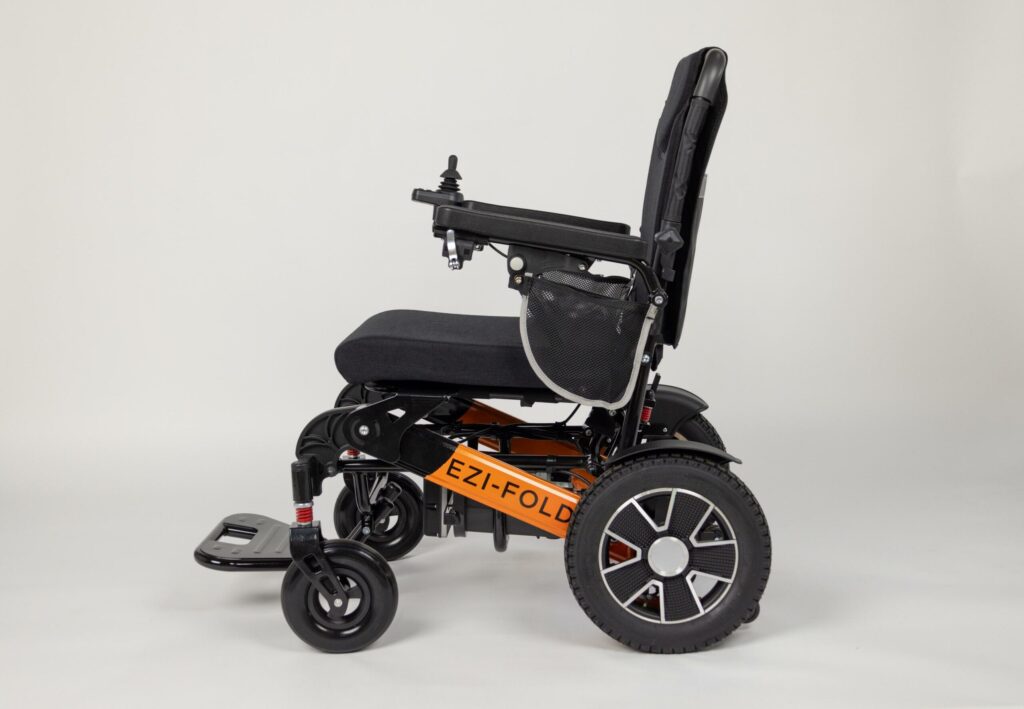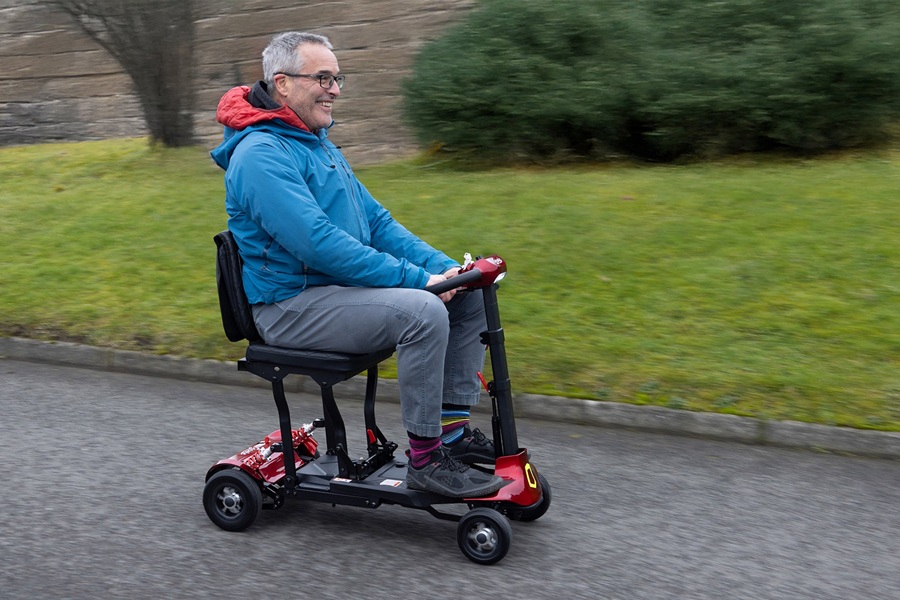
Power wheelchairs, also known as electric wheelchairs or powerchairs, are an excellent way to improve mobility and independence. They have a battery or electric motor and can be easily manoeuvred using a joystick.
Choosing a power wheelchair can be complicated—it’s not a case of one size fits all. Several factors to consider include storage, usage, budget, and individual mobility needs.
In this guide, we’ll look at the different types of electric wheelchairs available for your needs so you can make an informed decision before buying a powerchair.
Your level of mobility may influence how you get in and out of a power wheelchair, as well as any extra features you may need.
If you can walk short distances and stand and sit with relative ease, you likely won’t need assistance to get in and out of a wheelchair. However, if you sometimes struggle to go from a sitting to a standing position, it might be a good idea to opt for a wheelchair with an adjustable seat height, putting less strain on your muscles and enabling you to slide from the chair to another seat, such as a car, sofa or bed.
All power wheelchairs have footrests that can be moved outwards or flipped up out of the way when you sit or stand. Moving the footrests when you stand will prevent a trip hazard, leading to a possible fall; plus, you will not be tempted to put your weight on them, which could cause the chair to tip over. Many powerchairs also have flip-up or removable armrests to support movement.
You might also need to consider your weight and height when picking an electric wheelchair to ensure optimal comfort.
Will you use your electric wheelchair indoors, outdoors or both? Will you want to travel long distances in your power wheelchair? What are the rules for using a powerchair?
Some powerchairs are suitable for indoor use only, but others can be comfortably used indoors and outdoors. For powerchairs that will be used outdoors, keep in mind your local terrain. Are the pavements flat and easy to access? Are there any steep hills? Do you need to access uneven tracks?
If you expect to regularly travel long distances in your powerchair, you should check the chair’s battery range and make sure you charge the battery regularly.
Electric wheelchairs have traditionally been rear-wheel drive, with the driving wheels located at the back of the chair. This offers more comfort and better performance when outdoors and at higher speeds. However, they are less manoeuvrable in small indoor spaces.
Front-wheel drive power wheelchairs offer great indoor and outdoor performance. The driving wheels are located at the front of the chair, ensuring a better turning circle, which is ideal for compact indoor spaces. They also offer better traction outdoors for a smoother ride. However, they can be trickier for beginners to drive.
Mid-wheel drive powerchairs have the drive wheels in the centre of the chair, with additional smaller wheels at the front and back. They offer superior stability and a better turning circle; however, they can struggle on uneven terrain.
Your comfort is of the utmost importance in electric wheelchairs, especially if you spend a long time in a powerchair or require additional postural support. Padded seats, backrests, footplates, and armrests can all help with your comfort, enabling you to stay in the powerchair for longer.
Most electric wheelchairs have a standard seat size, so it’s important to try before you buy. Likewise, while padded seats come as standard, you may wish to upgrade to a thicker pad for additional comfort. Padded or moulded seat cushions can also keep your body aligned so you are not leaning to one side.
If you have more complex needs, you may need to opt for a more high-end electric wheelchair with adjustable seats and additional features.
It’s important to think about how and where you will store your power wheelchair. An electric wheelchair should be stored in a secure and dry place close to a power outlet so that the battery can be charged. You will also need to avoid blocking a fire exit or creating a trip hazard.
If the chair is stored outside, you should get a waterproof cover or keep it in a shed so that rain, wind, or heat will not damage it.
Your storage place should preferably be level to the ground or have ramped access so you can easily move it in and out.
If you need to transport your powered wheelchair in a car or on public transport, you might want to opt for an electric folding powerchair.
Most powered wheelchairs can be adapted and customised to fit your individual requirements.
Electric wheelchairs will have padded seats as a standard feature, but if you are using the chair for most of your day, you may want to invest in extra padding and support for your lower back to help relieve pressure on joints and muscles. There are plenty of cushions, seats, backrests, and supports to suit your individual needs and preferences and keep you comfortable and supported in a power wheelchair.
You may also want to consider a belt or harness, which can assist with alignment, maintaining an upright posture, and improving your safety when using a chair. A harness that secures around your shoulders and torso supports your upper body; you can also attach straps that hold your legs in place.
Standard powered wheelchairs have a basic range of seating height adjustments, whereas a configurable electric wheelchair can be made to measure, providing the best possible fit for optimal comfort.
The cost of an electric wheelchair depends on its size, battery and features. Prices can start from around £1,500.
It’s essential to make sure that whichever electric wheelchair you choose suits your individual needs. Purchasing a wheelchair can be a significant investment, so it’s important to take the time to research your options and, if possible, try different models before making a decision. If you are unable to afford an electric wheelchair, you may be able to gain funding from Motability.
When choosing an electric wheelchair, you will also need to consider the costs involved in charging the battery, as well as maintenance and repairs.
Powered mobility devices offer many benefits to users, but there are also risks of accidents due to lack of practice before using them.
It has been found that basic training to improve driving skills and awareness of scooters or power wheelchairs greatly reduces the chance of accidents.
Learning to use a power wheelchair includes operating and controlling, manoeuvrability, awareness and safety, and legal requirements for using an electric wheelchair. Power wheelchair users must have a minimum visual acuity of 6/24; any lower and you will not be eligible to drive a powered vehicle such as a mobility scooter or electric wheelchair.
We hope we have helped you better understand the range of considerations needed when selecting a power wheelchair. At Monarch Mobility, we can provide advice and support when choosing the most suitable electric wheelchair for your needs. Contact us for more information or for a free home demo.

Will you be joining us at the Motability Harrogate event on the 1st and 2nd of August?